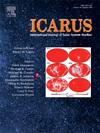Saturn's F ring is confined by Prometheus and negative diffusion
IF 2.5
2区 物理与天体物理
Q2 ASTRONOMY & ASTROPHYSICS
引用次数: 0
Abstract
Saturn's narrow, clumpy F ring is a region disturbed by chaotic orbital dynamics, that we model as a stochastic process (specifically, a finite Markov chain). The ring appears dominated by dust in camera images, but the main mass of this ring resides in a core of elongated clumps we call kittens, observed by ring occultations. Cassini UVIS sees such features about 1/3 of the time, the same frequency as the radio occultation detections of the F ring core; both have similar size distribution. We model the F ring core as composed of these transient aggregates, with size.
100 m < dr < 3 km. The Markov chain follows transitions between states in discrete semi-major axis bins, including both perturbations due to Prometheus encounters and mutual collisions. We solve for the stationary state and convert the semi-major axis distribution to distribution in longitude by modeling the libration as a simple harmonic oscillator. We find that without confinement, the probability of detecting the kittens is uniformly distributed. With corotation resonance confinement, the stationary state is sharply peaked, inconsistent with a purely random distribution. Considering shepherding alone, the Cassini radio observations are nonetheless better fit by the non-confinement stationary distribution, and even better by just 20 % confined. We find acceptable fits for fractions up to 70 % of the clumps shepherded in the 109:110 Prometheus corotation eccentricity resonance (CER), as proposed by Cuzzi et al. (2024). This finding expands their explanation to allow us to conclude that either some fraction of the population, or some fraction of the time, the F ring is shepherded by Prometheus. Additionally, we argue that the persistence of the F ring is due to negative diffusion, where the ring is confined by Prometheus aligning particle phases. Including the negative diffusion in the Markov chain using an Ehrenfest diffusion model, a small asymmetry explains the distribution in resonant angle of the radio occultation detections. In both these explanations, Prometheus is the agent for confinement. We conclude the F ring is shepherded by a combination of a Prometheus corotation and a Lindblad resonance that yields non-isotropic collisions. When the centroid of mass of the material in the F ring (the mass-weighted semi-major axis) is ever located at the Lindblad resonance with Prometheus, perturbations will drive negative diffusion to maintain that location. For our combined model: Shepherded fraction has the range fshep < 0.2; Diffusion asymmetry factor Pneg has the range 0.48–0.50. The negative diffusion thus can maintain the longitudinal distribution either alone, or in combination with shepherding, if the mean motion resonance coincides with the true core of the F ring.
土星的F环受到普罗米修斯和负扩散的限制
土星狭窄、块状的F环是一个受混沌轨道动力学干扰的区域,我们将其建模为一个随机过程(具体来说,是一个有限马尔可夫链)。在相机图像中,这个环似乎主要由尘埃组成,但这个环的主要质量存在于我们称之为小猫的细长团块的核心,这是通过环掩星观察到的。卡西尼UVIS大约有1/3的时间看到这样的特征,与F环核心的无线电掩星探测频率相同;两者的大小分布相似。我们将F环核建模为由这些具有大小的瞬态聚集体组成。100米<;博士& lt;3公里。马尔可夫链遵循离散半长轴箱中状态之间的转换,包括普罗米修斯遭遇和相互碰撞引起的两种扰动。通过将振动建模为简谐振子,求解稳态并将半长轴分布转换为经度分布。我们发现,在没有禁闭的情况下,发现小猫的概率是均匀分布的。在同向共振约束下,稳态出现尖峰,与纯随机分布不一致。考虑到单独放牧,卡西尼号的无线电观测结果更符合非约束平稳分布,甚至只有20%的约束更好。我们发现,在Cuzzi等人(2024)提出的109:110普罗米修斯自转偏心共振(CER)中,高达70%的团块是可接受的。这一发现扩展了他们的解释,使我们能够得出结论,要么是部分人口,要么是部分时间,F环是由普罗米修斯管理的。此外,我们认为F环的持久性是由于负扩散,其中环被普罗米修斯对准粒子相限制。利用Ehrenfest扩散模型将马尔可夫链中的负扩散考虑在内,发现了掩星探测共振角分布的小不对称性。在这两种解释中,普罗米修斯都是禁闭的代理人。我们得出结论,F环是由普罗米修斯共振和产生非各向同性碰撞的林德布拉德共振的组合所引导的。当F环中物质的质心(质量加权半长轴)位于与普罗米修斯的林德布莱德共振时,微扰将驱动负扩散以保持该位置。对于我们的组合模型:牧羊分数的范围为fsheep <;0.2;扩散不对称系数Pneg的取值范围为0.48 ~ 0.50。因此,如果平均运动共振与F环的真核一致,则负扩散可以单独维持纵向分布,也可以与牧羊结合。
本文章由计算机程序翻译,如有差异,请以英文原文为准。
求助全文
约1分钟内获得全文
求助全文
来源期刊

Icarus
地学天文-天文与天体物理
CiteScore
6.30
自引率
18.80%
发文量
356
审稿时长
2-4 weeks
期刊介绍:
Icarus is devoted to the publication of original contributions in the field of Solar System studies. Manuscripts reporting the results of new research - observational, experimental, or theoretical - concerning the astronomy, geology, meteorology, physics, chemistry, biology, and other scientific aspects of our Solar System or extrasolar systems are welcome. The journal generally does not publish papers devoted exclusively to the Sun, the Earth, celestial mechanics, meteoritics, or astrophysics. Icarus does not publish papers that provide "improved" versions of Bode''s law, or other numerical relations, without a sound physical basis. Icarus does not publish meeting announcements or general notices. Reviews, historical papers, and manuscripts describing spacecraft instrumentation may be considered, but only with prior approval of the editor. An entire issue of the journal is occasionally devoted to a single subject, usually arising from a conference on the same topic. The language of publication is English. American or British usage is accepted, but not a mixture of these.
 求助内容:
求助内容: 应助结果提醒方式:
应助结果提醒方式:


